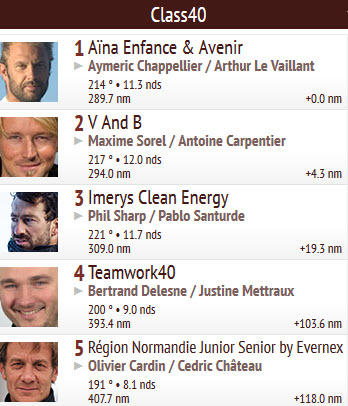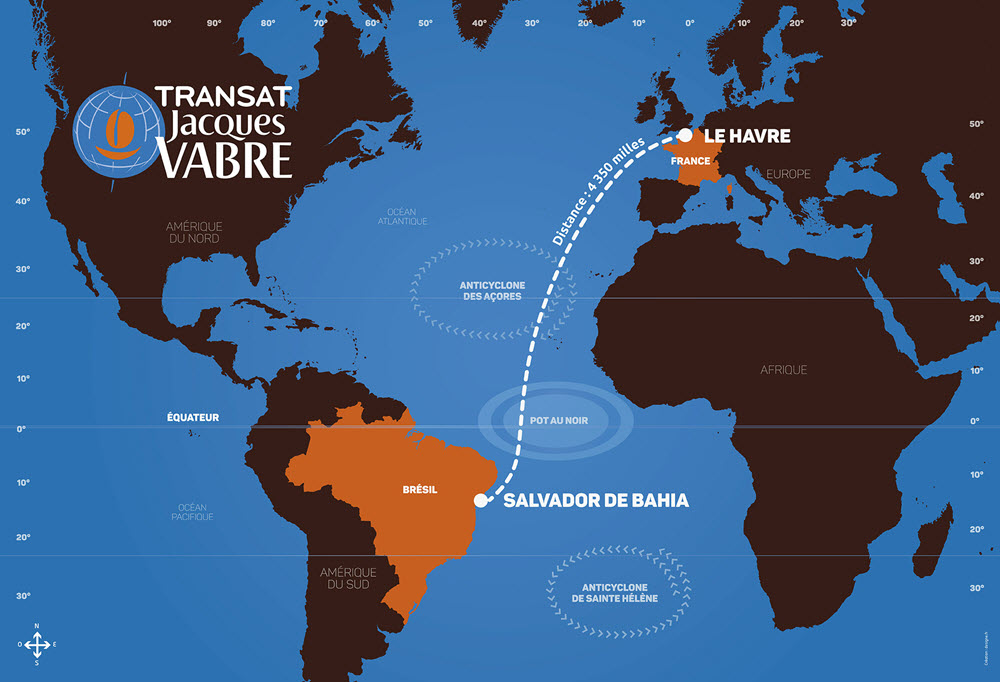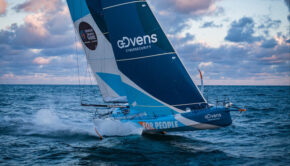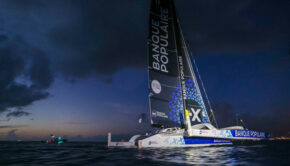Final night for Class40 victory
Published on November 21st, 2017
 (November 21, 2017; Day 16) – It is a three-horse race down the coast of Brazil for the lead Class40s in their approach to the finish in Transat Jacques Vabre. Locked together for the last fortnight, the three boats are passing Recife with less than 300 nm to go and an ETA of 22:00 UTC tomorrow.
(November 21, 2017; Day 16) – It is a three-horse race down the coast of Brazil for the lead Class40s in their approach to the finish in Transat Jacques Vabre. Locked together for the last fortnight, the three boats are passing Recife with less than 300 nm to go and an ETA of 22:00 UTC tomorrow.
The three boats are all Manuard design, but the top two boats are version 3 of the Mach 40 design while the Anglo-Spanish duo of Phil Sharp and Pablo Santurde (Imerys Clean Energy) is a version 2 and simply slower in the reaching wind angles they have had since the Doldrums. It may only be a half a knot, but over 24 hours that is heartbreaking.
Design physics has forced them into a tactical decision to head further offshore in the search for more wind, whilst the two front boats gybe closer to the coast (they are 12 miles from land). As the trade wind begins to swing behind them this evening, Imerys Clean Energy, should be able to hold its own. But until then perhaps their best hope is that the French boats will push too hard against each other.
Race details – Entry list – Tracker – Facebook
13th edition of the Transat Jacques Vabre
• Biennial doublehanded race now 24 years old
• Two founding partners: the city of Le Havre and brand Jacques Vabre
• Four classes on the starting line: Class40, IMOCA, Multi50, and Ultimate
• Starting November 5 in Le Havre (FRA) for the 4350nm course to Salvador de Bahia (BRA)
n 2013, and again in 2015, all the boats flew past Salvador de Bahia, sails filled by the trade winds of the south-east, under the tropical sun…One imagines that they dreamt of finally finishing their race in All Saints’ Bay. In 2017, it will be a reality!
After the start line and a coastal route as far as Etretat, the duos will head towards Brittany to get out of the Channel as quickly as possible, where the currents are powerful, cargo traffic dangerous, and a lot of attention is needed.
They will then enter the Bay of Biscay, where, depending on the position of the Azores anticyclone, they will either find downwind conditions, easy and fast, like for the last Vendée Globe, or tougher and slower conditions in the passage of some late autumn depressions.
Four hundred miles later, having passed Cape Finisterre, the northern Portuguese trade winds should propel them quickly towards Madeira, and then the Canary Islands, where awaiting them will be northeast trade winds, which could be strong or weak.
Passing close to the Portuguese coast, or offshore, to the east or west of the Canary Islands and then the Cape Verde islands – you have to choose the right options. The next goal is to establish your position for the crossing of the dreaded Doldrums, located a few degrees north of the equator. At this time of year, it can change position very quickly, extend or contract, because even after carefully studying of the satellite images, sudden squalls can develop and stall the competitors under a good shower without wind for hours.
This passage is crucial in the Transat Jacques Vabre racecourse. Further west… Further east… After the calms, rainy squalls, with too much or no wind… The final goal is to get out well-positioned enough to benefit first from the southeast trade winds and to cover the remaining 850 miles towards the finish,passing along the islands of Fernando de Noronha, along the coast of Brazil and finally heading northwest into the magnificent All Saints’ Bay.
This transoceanic racecourse from North to South is more demanding than a transat from East to West; it requires the skippers to have sharp tactical and strategic qualities, good weather training, to be in excellent physical condition to maintain a sustained speed in the trade winds… And to have a lot of patience to cross the equator.
Source: Transat Jacques Vabre










 We’ll keep your information safe.
We’ll keep your information safe.